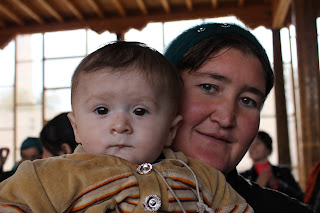Our first point of call is the Khast Imom religious centre,
where the main museum holds an original of the last ancient Quran in the world,
the Osman Quran, dating back to the 7th century. It’s an impressive
tome, about 1 ½ metres wide when open
and written in beautiful Arabic calligraphy (I couldn’t help but think whether
in some strange way kufic script was derived from hieroglyphs!). The museum
also houses other ancient and beautifully decorated hand-written Qurans, graced
with colourful red, gold and blue motifs along the margins, and dating back to
the 12th-13th centuries.
We meander through the lanes of the old town and revisit the
bustling Chorsu Bazaar, before heading for the more modern part of town, to the
Amir Timur and Mustaquillik Maydoni, an area characterised by President
Kharimov’s wide avenues, squares and giant, white-washed, palatial buildings,
standing next to exemplars of Russian architecture sometimes good (the
beginning of the 19th century Romanov Palace), sometimes really bad
(the Soviet architecture of the Hotel Uzbekistan).
For the rest of the day we enjoy the company of a very
bright and interesting young Uzbek man, a friend of a friend in London, who
takes us to the city’s newest mosque, financed in part by the Uzbek Russian
oligarch Usmanov, to the modern version of an Uzbek bazaar (where a startled
fruit seller says ‘seriozna?’ - seriously? in Russian – when my friend Sejal
says she’s from ‘Anglia’ – England , followed by all of us bursting into
laughter as it is obvious that he also thinks she’s a Bollywood movie star) and
end the day in a Chaykhaneh for a snack and pot of green tea and later in a
Kyrgiz restaurant called Manas for dinner in a ‘yurt’ (a nomad tent). We really
enjoy talking to him and he helps us fill in some of the ‘blanks’ we had in
better understanding his country.
It has been a really special holiday. Following my visits to
Iran and Georgia, the Uzbek adventure has yet again confirmed that Central Asia
is a region of the world I want to learn more about. Watch this space…;-) I’ll
be back.



































































































